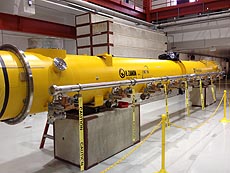Newly completed cryomodule transported to NML
 |
|
Fermilab's homegrown cryomodule CM2 was transported to NML last month. It replaces Cryomodule 1, which was assembled from a kit from DESY. Photo: Elvin Harms |
In 2007, personnel from the German laboratory DESY and the Italian institute LASA came to Fermilab to assist technicians, engineers and scientists in the assembly and operation of Cryomodule 1, a superconducting radio-frequency cryomodule.
Now Fermilab is losing the training wheels: it is installing a real homegrown SRF cryomodule. RFCA002, nicknamed CM2, is replacing CM1.
Cryomodule 1 was used as a training ground for Fermilab to prove that the SRF infrastructure worked and to give its personnel hands-on experience assembling and operating multi-cavity cryomodules.
"The difference between CM1 and CM2 is that CM1 was a kit that DESY delivered to us for assembly at Fermilab," Elvin Harms said. "CM2 is more advanced and will be used not only for SRF R&D but eventually for physics as well."
SRF technology is the basis of future particle accelerators such as the proposed International Linear Collider and Project X. Superconducting radio-frequency cavities accelerate particles by sustaining an electric field that oscillates between positive and negative pulses to push and pull charged particles from one cavity cell to the next.
CM2 is a next-generation SRF cryomodule. It uses high-performance components specifically designed with the ILC and Project X in mind. Compared to conventional radio-frequency systems, SRF technology provides orders-of-magnitude increase in performance.
"The hope for CM2 is that it will be the first cryomodule to reach the average ILC specification gradient at Fermilab," said lead engineer Tug Arkan. "That's the goal to demonstrate. We haven't yet proved it at Fermilab."
Fermilab purchased the eight cavities in CM2 from industries in Europe and the United States and vertically tested them at Jefferson Lab and Fermilab. The brand-new cavities underwent an initial test in which they were submerged in liquid helium and charged with continuous RF waves. They were then placed in helium jackets, outfitted with input couplers and tested again with high-power pulsed RF waves at Fermilab's Horizontal Test Stand. Finally, they were installed in CM2. Fermilab directed the entire process.
"This was a very different experience from last time when DESY and LASA helped us," Harms said. "We were in charge the whole way through: we made sure the cavities were built to our specifications, tested them, dressed them and pulled everything together."
CM2 was transported to the NML building on April 26. In the coming days, it will be placed on its stand in the NML cave. It will then undergo commissioning and testing as a complete cryomodule and eventually accelerate an electron beam.
"Our goal is that we will have a cold operating cryomodule late this summer and run an electron beam through it by March 2013," Harms said. "Then we can use it for science."
—Sarah Charley
|